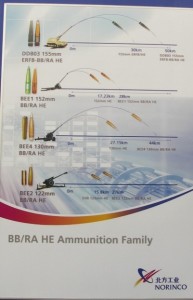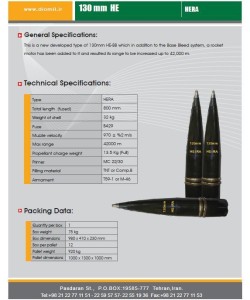Yuri Lyamin
In 2006, some sources indicated that China North Industries Corporation (Norinco) had developed a new 155 mm HE projectile design which incorporated two auxiliary propulsion techniques – base bleed (BB) and rocket assistance (RA). Shortly after these early reports emerged, it became apparent that Norinco had in fact developed a new family of extended-range HE projectiles for 122, 130, 152, and 155 mm artillery systems. Information on these projectiles was first publicly presented at Abu Dhabi’s 2007 International Defense Exhibition (IDEX 2007).
Amongst other projectile types was a 130 mm rocket-assisted projectile (RAP) designated the BEE4, designed for use with 130 mm guns such as the M-46, Type 59, and Type 59-1. The Soviet M-46 was developed in the late 1940s, with full-scale production underway by 1954. The gun was later produced under license by China, adopted in 1959 as the Type 59. This was further modernised to significantly reduce the weight of the weapon, with the adoption of a new carriage (from the Type 60 122 mm gun) and muzzle brake. The modernised gun is known as the Type 59-1.
Despite their age, these 130 mm Soviet and Chinese guns are still very common in the armed forces of several countries, including China, thanks to their long range capability. Even with standard HE projectiles, they have a range of 27 km. By way of comparison, the US M198 155 mm howitzer firing M107 HE projectiles has a range of 22.4 km (note that other nations have developed projectiles with auxiliary propulsion for 155 mm guns that meet or exceed the range of the BEE4). The Chinese BEE4 130 mm BB/RA projectiles increases the maximum effective range from 27 to 44 km. Not long after the BEE4 projectile’s debut at IDEX 2007, Iran’s Defense Industries Organisation presented a 130 mm BB/RA projectile which has a claimed range of 42 km. One effect of this increased range is a commensurate reduction of precision at the longer ranges.
In mid-May 2015, images surfaced of a Syrian Arab Army soldiers posing with a 130 mm BEE4 BB/RA projectile. The soldiers were part of the crew of a 130 mm self-propelled gun (SPG). 130 mm gun and 122 mm D-30 type guns form the basis of the Syrian artillery. These SPG were developed in Syria prior to or in the early stages of the current conflict, by installing 130 mm M-46 guns on heavy trucks. They have been used by government forces from at least 2013.

Markings visible on the packaging indicate that the BEE4 projectiles were supplied under a contract from 2007. This is likely to mean that Syria was one of the first foreign buyers of these munitions.

With thanks to Mathieu Morant and @bm21_grad.
Remember, all arms and munitions are dangerous. Treat all firearms as if they are loaded, and all munitions as if they are live, until you have personally confirmed otherwise. If you do not have specialist knowledge, never assume that arms or munitions are safe to handle until they have been inspected by a subject matter specialist. You should not approach, handle, move, operate, or modify arms and munitions unless explicitly trained to do so. If you encounter any unexploded ordnance (UXO) or explosive remnants of war (ERW), always remember the ‘ARMS’ acronym:
AVOID the area
RECORD all relevant information
MARK the area to warn others
SEEK assistance from the relevant authorities




2 thoughts on “Chinese BEE4 BB/RA 130 mm projectiles in Syria”